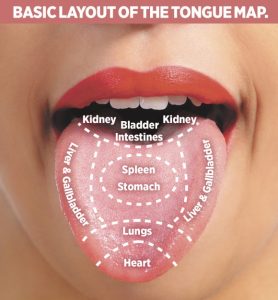The Tongue Is a Map of the Body in Chinese MedicineMar 29, 2018

Your tongue does more than just taste food and articulate words. According to traditional Chinese medicine, it is also a convenient diagnostic tool.
Before X-rays, MRIs, and CT scans, ancient doctors had other methods to examine the internal health of their patients. Tongue diagnosis is one such practice still widely used today. For those who know how to read the tongue’s secrets, it can reveal signs of disease and imbalance that the patient may not share or even know.
In Chinese medicine, the tongue serves as a map of the internal organs. The tip of the tongue reflects organs that are higher in the chest: the lungs and heart. The middle of the tongue represents organs that are in the middle of the trunk: liver and gallbladder on the sides and the stomach in the center. The back of the tongue reflects organs deeper in the trunk, such as the intestines, bladder, and kidneys.
Abnormalities found on the tongue map can give an acupuncturist clues to where a patient’s imbalances are located, and how best they can be treated.

According to Eric Baker, a Chicago-based acupuncturist and professor at the Pacific College of Oriental Medicine, the concept of tongue diagnosis stem from a holographic perspective that permeates much of ancient Chinese culture.
“In a hologram every part of the picture is a reflection of the whole,” Baker said. “In Chinese medicine each part of the body is like a miniature of the whole body. In Western scientific culture you might call this self-similarity. It’s sort of a fractal way of looking at things.”
In addition to its holographic nature, the tongue is a unique organ because it exists in two realms. It’s not quite an internal organ, but it’s not quite an external one either. You have to open your mouth wide and stick out your tongue in order to get a good look at it.
Usually the signs on the tongue map are subtle, and can easily escape the untrained eye. But extreme cases can produce undeniable examples.
Baker mentions a past patient of his, a woman in her late 40s to early 50s with hepatitis C that could not be controlled with modern Western medicine. She complained of pain on her right side, where her liver is located. Remarkably, her tongue pointed to severe liver problems too. Baker saw a black spot on the right edge, exactly where the liver is located on the tongue map.
“I tell students to go in with an open mind but you also want to be critical. You don’t want to believe just anything it says in the textbook. But then you get cases like this that are so perfect,” Baker said. “Here’s a lady with a liver problem and she has the exact indication you would expect—a black spot showing deeper damage to the liver from uncontrolled infection. This is Chinese medicine doing exactly what it’s supposed to do.”
Color, Coat, Cracks, and Quivers
Stick out your tongue in front of an acupuncturist and its color will be the first thing they notice.
A healthy tongue is a pinkish red—a sign of good circulation. If the circulation is restricted—in cases of menstrual pain, for example—the tongue will be more purple. A pale tongue is a sign of a lack of blood, such as anemia. If a tongue goes too red it may indicate a fever or high blood pressure. If a tongue is extra red in a particular area of the tongue map this demonstrates internal heat in the corresponding organ. For example, a red tongue tip could be a sign of infection in the lungs or what Chinese medicine calls “heart fire,” a condition characterized by anxiety and insomnia.
Another tongue characteristic to consider is the coat. Look at your tongue in the mirror and you may notice that it wears a film on its surface. This is called the “tongue coat,” or “tongue fur.” You can try brushing the coat off with a toothbrush but it will soon sprout a new one. A thin white coat is considered healthy—a sign of good digestion. A thick, greasy, or yellow coat may reveal signs of imbalance.
“If someone has a lot of phlegm with nasal congestion or a cough, when you look at the tongue coat in these people, it’s thicker and heavier. Or it may start to get sticky, showing that there are these excess obstructive fluids collecting in the body,” Baker said.
A tongue examination requires good lighting and a clean tongue. For example, you won’t get an accurate reading immediately after someone eats a handful of Skittles or a grape flavored popsicle. Coffee is notorious for yellowing the tongue coat. Other foods and drugs can also temporarily obscure the tongue’s true colors.
Besides color and coat, the tongue also holds other clues to consider, like cracks, swelling, patches, and movement. A scalloped tongue (one with ridges on the outside edge) indicates fluid retention. These ridges develop because the tongue swells and presses against the teeth.
Some people also have a quivering tongue— try as they might, it just won’t sit still. This is a sign of what Chinese medicine calls internal wind.
“If you have a disease like MS or Parkinson’s where there are tremors, you’ll see that the tongue body itself will quiver and tremor. That’s an indication that there are neurological things going on and a lack of proper motor control,” Baker said. “Sometimes you may even see that preemptively in certain things. A tongue quiver may appear before a stroke for example, where there can be neurological damage afterwards. You can see a quivering in the aftermath of some more serious diseases, but you might see it in certain situations as a predictor.”
by Conan Milner For The Epoch Times
Be the first to post a message!